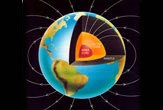
Scientists have spotted a thick layer of melted rock beneath the Earth’s crust that could be part of a fluid band of hot magma circling the globe. The magma ring has until now remained a theory.
The molten-rock layer is 10 miles thick and can’t be seen, felt or smelt from the surface. Researchers Daniel Toffelmier and James Tyburczy of Arizona State University found the layer using a relatively new technique that measures changes in weak electrical currents flowing through the Earth’s mantle rock.
The current is created when the solar wind, a continuous flow of charged atomic particles emitted by the sun, interact with Earth’s magnetic field, called the magnetosphere.
The chemical make-up of the rocks affects their conductivity. By measuring changes in the current at different depths, the scientists were able to detect distinct rock layers, including the "invisible" magma layer.
“Rocks are semiconductors,” Tyburczy said. “And rocks with more hydrogen embedded in their structure conduct better, as do rocks that are partially molten.”
The discovery, detailed in the June 21 issue of the journal Nature, partially confirms a recent hypothesis by two Yale University geoscientists, which states that a band of molten magma circles the Earth about t 250 miles beneath the planet’s crust, near a hypothetical “transition zone” separating the planet’s two mantle layers.
The idea is that as the rock rises from the lower mantle to the upper mantle, it expels all the water in its crystal structure and melts.
Get the world’s most fascinating discoveries delivered straight to your inbox.
The researchers detected the molten layer beneath Tucson, Arizona. They aren’t sure how far the sheet extends, but say there is little chance any of the molten rock will erupt at the surface.
The discovery only partially confirms the Yale scientists’ idea, since it reveals a molten magma layer only beneath one spot on the Earth. But “finding that sheet of melt-rock tells us we’re on the right track,” Tyburczy said.
- Finally, a Solid Look at Earth's Core
- Blobs Inside Earth Might Explain Rapid Mountain Building
- Planet Earth: A Year of Pictures
